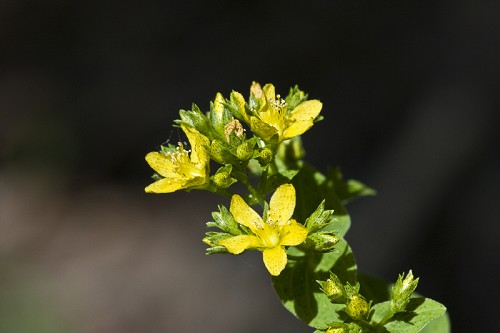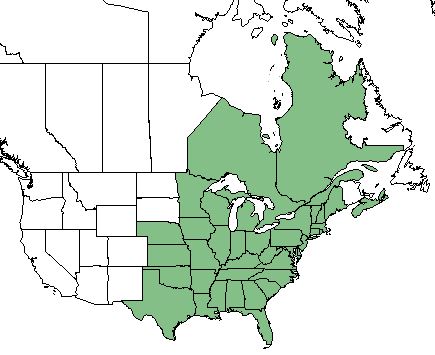Hypericum punctatum
spotted St. John's-wort [1]
| Hypericum punctatum | |
|---|---|

| |
| Photo by the Southeastern Flora Plant Database | |
| Scientific classification | |
| Kingdom: | Plantae |
| Division: | Magnoliophyta - Flowering plants |
| Class: | Magnoliopsida - Dicots |
| Order: | Theales |
| Family: | Clusiaceae |
| Genus: | Hypericum |
| Species: | H. punctatum |
| Binomial name | |
| Hypericum punctatum Lam. | |

| |
| Natural range of Hypericum punctatum from USDA NRCS Plants Database. | |
Contents
[hide]Taxonomic Notes
Synonyms: Hypericum punctatum Lamarck var. punctatum; Hypericum subpetiolatum E.P. Bicknell ex Small
Description
H. punctatum is a perennial forb/herb of the Clusiaceae family native to North America. [1]
Distribution
H. punctatum is found throughout the eastern United States and up into Eastern Canada, specifically Ontario and Quebec. [1]
Ecology
Habitat
H. punctatum has a low tolerance for drought. It is tolerant of shade. [1] It is commonly found in fields and woodland borders.[2] This species also prefers partial shade, and has a low tolerance for calcium carbonate.[3] Specimens of H. punctatum have been collected from upland pinelands that are annually burned, and other similar sandhill habitats that are well-drained.[4]
Phenology
Flowers bloom in the early summer months.[1] It commonly flowers between June and September.[2]
Seed dispersal
This species is thought to be dispersed by gravity. [5]
Fire ecology
H. punctatum is not a fire resistant forb but has a mild tolerance to fire. [1]
Pollination
This species is considered by pollination ecologists to be of special value to bumble bees since the flowers attract such large numbers for pollination.[3]
Use by animals
It has been recorded to be eaten by white-tailed deer.[6]
Conservation and Management
It is considered vulnerable in the Canadian province Quebec, critically imperiled in Nebraska, and an exotic species in the Canadian province Newfoundland.[7]
Cultivation and restoration
Photo Gallery
References and notes
- ↑ Jump up to: 1.0 1.1 1.2 1.3 1.4 1.5 USDA Plant Database
- ↑ Jump up to: 2.0 2.1 Weakley, A. S. (2015). Flora of the Southern and Mid-Atlantic States. Chapel Hill, NC, University of North Carolina Herbarium.
- ↑ Jump up to: 3.0 3.1 [[1]] Lady Bird Johnson Wildflower Center. Accessed: May 28, 2019
- Jump up ↑ Florida State University Robert K. Godfrey Herbarium database. URL: http://herbarium.bio.fsu.edu. Last accessed: May 2019. Collectors: Wilson Baker, Robert K. Godfrey, Jeffrey M. Kane, Roy Komarek, and R. A. Norris. States and Counties: Florida: Leon. Georgia: Thomas.
- Jump up ↑ Kirkman, L. Katherine. Unpublished database of seed dispersal mode of plants found in Coastal Plain longleaf pine-grasslands of the Jones Ecological Research Center, Georgia.
- Jump up ↑ Atwood, E. L. (1941). "White-tailed deer foods of the United States." The Journal of Wildlife Management 5(3): 314-332.
- Jump up ↑ [[2]] NatureServe Explorer. Accessed: May 28, 2019